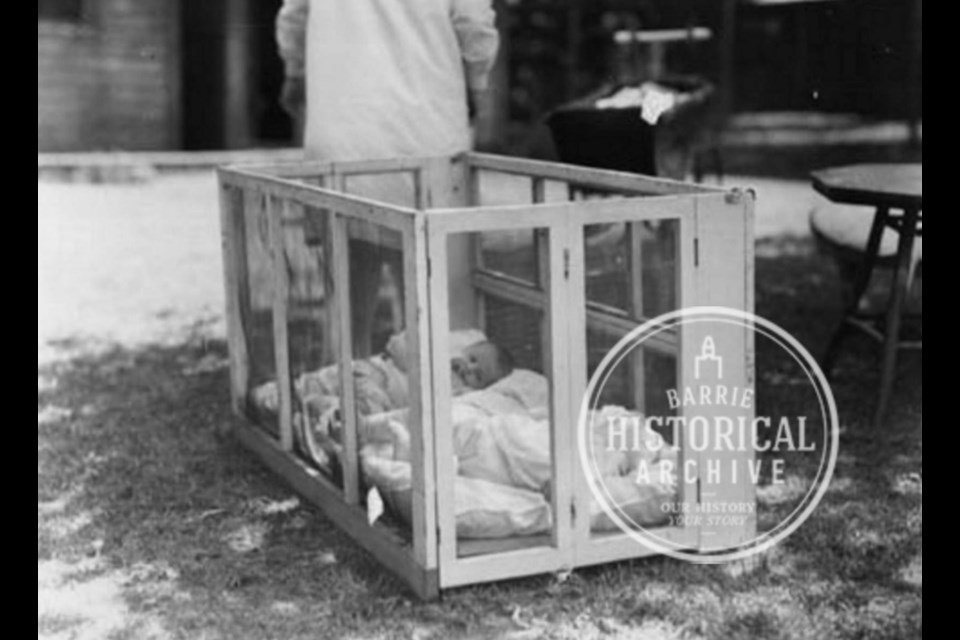The weather is becoming warm and pleasant now. This was the time of year that our Victorian great-grandmothers began to watch for signs of summer complaint in their small children.
Summer complaint was a catch-all term for seasonal digestive issues that were annoying to most people but deadly for infants and the elderly. During the hottest months of the year, medically vulnerable people commonly died from cholera infantum, dysentery, diarrhea and other related maladies.
On a single page of Barrie death registrations from the summer of 1887, there were three such fatalities listed. Ada Emily McAllister, infant, Stuart McGregor, six months, and Amelia Hawkins, 80 years of age. Sadly, this is just one page of many and this was typical of the era.
Likely, they had tried all the usual remedies in vain. The go-to treatment was always a stiff dose of the trusted castor oil.
Of course, there were plenty of other well-lauded cures out there. Most downtown Barrie drug stores would likely have carried Chamberlain’s Colic Cholera and Diarrhoea Remedy. It was a lovely concoction of alcohol, ether and chloroform.
Prior to 1906, when Chamberlain’s was sued after the death of a child, the product also contained opium.
Then there was Dr. Kellogg’s Dysentery Cordial, and Dr. Fowler’s Wild Strawberry Extract, which was a blend of strawberry leaves and tannic acid. Surprisingly, a form of this product is still available today but with markedly different ingredients.
The real issue was the lack of proper food handling, but this wasn’t something that was well understood in the 19th century. The prevailing theory was that untidy yards and household garbage decaying in the heat caused “the air to become full” with toxic vapours that were absorbed by fragile people.
By the 1890s, some doctors were beginning to make connections between things happening in the microscopic world and the heat of summer. They also noticed a dramatic rise in summer complaint among children older than six months as opposed to younger ones.
They were on the right track but hadn’t put it all together yet. Truly, physicians of that era didn’t have a lot to work with. Their medical training had included plenty of anatomy but it was the habits of micro-organisms that eluded the medical people.
As it turned out, milk products were the chief cause of summer complaint. Older babies were often weaned from breast milk and started on cow’s milk.
Dairies of the 1800s weren’t the highly sanitary operations of today and all kinds of contaminants found their way into the milk.
The final ingredient for this disastrous recipe was the warm weather itself. Milk was delivered by horse and cart and placed outside homes and hotels, where it sat at unsafe temperatures for far too long.
Modernization was coming but even some of those advances were unknowingly contributing to the problem.
In the 1860s, a young middle-class Englishwoman who had a magazine publisher for a husband wrote a book that would become the manual for Victorian households. When Mrs. Beeton’s Book of Household Management debuted, Isabella Beeton became an instant domestic guru.
Beeton did not invent the baby bottle but she certainly used her platform to promote a particular type, which led to its popularity taking off like a rocket.
Mothers naturally wanted the best for their babies but this was the corset era and breastfeeding was difficult. Enter the newfangled banjo bottle, so named for its shape — round, flat, with a narrow neck. It featured a rubber stopper that led to a long rubber hose with a nipple at the end.
The design made the bottle tough to clean. No big deal. Mrs. Beeton advised her readers that the nipple and tubing would not require cleaning any more frequently than every two weeks anyway. These devices were eventually known as murder bottles, and banned.
Each week, the Barrie Historical Archive provides BarrieToday readers with a glimpse of the city’s past. This unique column features photos and stories from years gone by and is sure to appeal to the historian in each of us.



